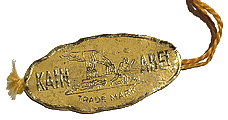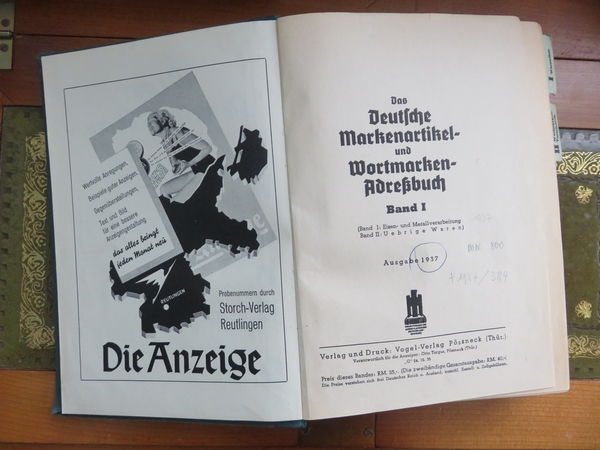From 2003 to 2006, I worked at a Düsseldorf engineering office, whose premises were housed on the old plant ground of the Böhler steelworks on the city border to the town of Meerbusch. The industrial charm of the location was underlined by the direct neighborhood to the old boiler house.
Only years later I noticed that despite my fondness for knives – folding knives in particular – I did not have a single knife with a blade made of Böhler steel. I started looking for such knives on eBay. Since the merging of Böhler with the Swedish steel manufacturer Uddeholm, most of the production has been transferred to other locations. So I was looking for old knives in particular to make sure that their production had indeed taken place in Meerbusch.
What I did find was not a folding knife, but a straight razor that had “Böhler ◊ Extra” engraved on it’s angle. I quickly found out that the star between the two words was one of the earliest registered trademarks in Germany. It was registered in 1894 by the Böhler Edelstahl GmbH. However, what I did not find out despite extensive internet research, was further information about the manufacturer or the brand “Kain + Abel”. (I had automatically assumed that Kain + Abel had to be a manufacturer’s name because the name “Kain + Abel Special” was inlayed on the yellowish celluloid handle.) With the help of the company Böhler, and based on the use of celluloid as a handle material, I was able to date the production period roughly to the first half of the 20th century. But even though I found information on about 20 different razors of Kain + Abel in online auction houses and forums right away, there seemed to be zero information on the manufacturer available. On the contrary, I found out that many owners of a Kain + Abel knife had the same questions as I did. But from the comments, it quickly became clear that no one on earth knew an answer. The relevant literature was of no help either. Even the exhaustively extensive reference work “German Knife and sword makers – the definitive directory of makers and marks, from 1850 to 1945” by J. Anthony Carter and John Walter did not lose a single word about Kain + Abel.
When John Walter himself finally confirmed to me that there was no mention of this company in his documents, I decided to find further information about Kain + Abel which I could then provide to the other owners of such razors for the first time.
But as it soon turned out, this was apt to be a difficult undertaking.
Cain, where is your brother Abel?
Despite the fact that I am living only about 10 kilometers away from the Solingen city archives, my first research was somewhat frustrating. The company Kain + Abel could neither be found in the extensive letterhead collection, nor in the old Solingen address books. A search in the collections of company photos and official documents remained unsuccessful as well.
Only one single book entitled „Das deutsche Markenartikel und Wortmarken Adressbuch“ (“The German brands and word-brands address book”) provided the all-important information. The first volume of this reference book from the year 1937 covers all companies involved in iron and metal processing and is again divided into two parts. Part 1 lists the companies in chronological order and assigns them to their respective brand names. Part 2 lists all brand names alphabetically and links them to the respective companies.
In part 1, I again couldn’t find anything. However, the book lists the name “Kain-Abel” as a word mark in part 2 and links the brand to the company Emil Broch in Solingen-Merscheid. But this was only the first important piece of information the book gave to me. Because back in part 1, the manufacturer’s name “Emil Broch Rasiermesserfabrik” (“Emil Broch Straight Razor Factory”) was linked not only to the brand Kain-Abel, but also to the brands Elsine and Bromeso.
With this important information, my research could start over again. But as it turned out, there was no evidence of Emil Broch in the existing sources as well. All the information collected on this site had to be compiled in detail and with the help of different people.
Therefore, I would like to thank some people for their energetic help in my search:
- Ernst Detlef Broch, who traced the different branches of the Broch family tree back to the 17th century and who gave me important information about Emil and Hugo Broch,
- Tim and Hans Ehlenbeck,
- Friedrich Lauterbach from the technichal service of the company Böhler in Meerbusch,
- Lutz Hoffmeister from the Solingen blade museum,
- Michael Tettinger for information on the Schaafenmühle “Kotten”,
- John Walter, co-author of „German Knife and Sword Makers“,
- Ulrich Herting from the surveying department of the city of Solingen, for the usage rights of old maps and aerial views,
- Frauke Gränitz from the Leipzig trade fairs,
- Ute Wnendt from the Cologne trade fairs,
- the employees of the Solingen city archives,
- and my wife Nicole, for everything else.
Postscript
More than two years after my quest began, an interesting Kain+Abel Special razor suddenly appeared in an auction. It’s tang read “Emil Broch / Solingen-Merscheid” on the front. If this razor would have surfaced earlier, the origin of the Kain-Abel mark might have been clarified years ago. In any case, this is the only razor known so far that establishes a direct link between the brand and its creator.

